It was a grey German morning -- chilly and drizzling, as I rushed to meet Tom Sello, Curator of Berlin's Peaceful Revolution Exhibition at Alexanderplatz -- a plaza in what was formerly known as East Berlin and the epicenter for protests during the cold war.
For Tom Sello, his Peaceful Revolution exhibit -- his life's dream of sharing freedom and his story with his fellow Germans, as well as whomever saunters by, stopping to read, peruse images of his time behind the wall -- has come to fruition. But maybe not for long, as the exhibit is set to come down this November.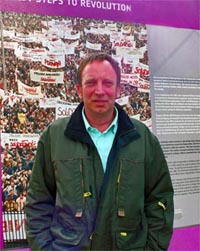
Sello is taking a stance by petitioning the government to keep his Peaceful Revolution in place as permanent tribute to what he calls a factual revolution that did indeed happen. To date, the government does not acknowledge that there was a "revolution" at all, merely an activist group that took a stance.
The night of the Fall of the Wall: November 9, 1989.
Having worked as a writer for most of my life, I've grown quite accustomed to a laid-back approach, but not this time. My interview with Tom had my emotions running high as butterflies danced in my stomach because I would be speaking with a man whose path had very much shaped my own 20 years ago.
I remember the night clearly. I was a young girl watching the evening news with my parents, utterly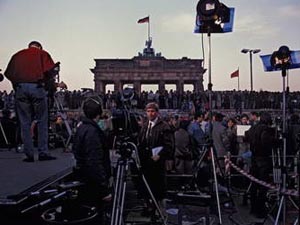
"On November 9th everything changed" said Werner Kolhoff, who served as chief of the West Berlin Communication Department during the fall of the Wall. "All of a sudden, everything went differently. During the protest people shouted no violence and no shooting or violence occurred. The guards let the people be. The happiest thing was that despite all of the violence over the past years, this was a peaceful end."
While the borderline somnolence of today's united Germany couldn't paint a starker contrast to the Cold-War era, remembering the strife and struggle of the immediate past--through exhibitions, monuments and memorials--remains high on the list of German culture's priorities.
Behind the Wall... An activist reborn
Tom Sello, now 51 years old, is a serious man, tall in stature with piercing blue eyes that tear up with emotion when speaking of his days in East Berlin.
We sat down in a bustling coffee shop to talk about what brought him to this point in life, what he wishes for the future, and to share his story. Now sitting across from him I couldn't help but notice a calm sadness in his demeanor.
Tom Sello's life initially was that of conformity. He served two years in the German army, which he says "was meant to break people and brainwash them into fitting into society." Once discharged, he quietly joined what was euphemistically referred to as an "environmental" group which created underground newspapers. Sello soon began distributing subversive anti-military fliers -- each painstakingly hand-typed on a typewriter smuggled in from the west. Had he been caught with anything, he said, he could have been sent to prison for ten years, or simply may have "disappeared."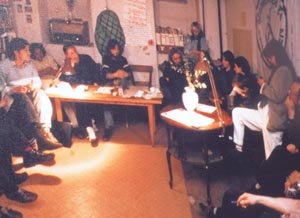
Sello was married with two children and living in a house full of squatters in Prenzlauer Berg, an area then known ground zero for opposition groups. The unofficial "library" environmental group he later joined in Nov. 1987, held their meetings in the basement of a Zionist Church. His Peaceful Revolution exhibit shows photos of the basement, documents the arrests of Sello and other activists by the Stasi (East Germany's notorious secret police) which had collected evidence via video and photographs from a prior spy mission. The Stasi also took Tom's precious type writer.
Sello said he still finds it hard to trust people even today "Fact: If you were active, you knew there were dangers," he shared.
What kept him from "disappearing?" I asked. "The Stasi had not calculated the exposure the west had been giving the group, and the attention that was being focused on them by the International press at the time," he said. He also believes being known in the western press saved his life.
But while the opposition continued to see small signs of success, they still could not foresee the wall coming down.
The Fall of the Wall
The last election of East Germany was ripe with what Tom calls as "folding paper"; in other words voting for the established party out of fear of negative consequences for not only those voters who might have voted against the government but for the safety of their families as well.
However, suspicion remained high after the election. Oppositional groups, including Sello's, wanted to view results of tallied votes and compare voting results given out by the state.
Strong discrepancies proved voting fraud. The details were then leaked to news outlets around the world "The western media was crucial, the strongest counterpart to the wining Socialist Unity Party of Germany," Tom explained.
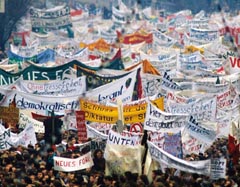
"At first, there would only be ten to twenty people show up to protest, but on Oct. 7- the 40th anniversary of the GDR, thousands showed up," Tom explains. "Security was there, but they would not do anything in front of the press, and also fearful the government might accuse them as being part of the protests."
Utilizing the escalating chaos unfolding in front of the media, demonstrators passed out pre-prepared lists of protesters who had been arrested which generated even more headlines around the world.
At Last, Freedom...
November, 9th at 6:57 p.m. proved to be surreal for Tom Sello. The GDR, facing negative worldwide press and looking for ways to relieve international pressure, decided to allow East Berlin residents to travel on special holiday visas to the west.
Sello recalled listening to the now famous press conference hosted by the Socialist Unity Party of Germany (SED) on Nov. 9, 1989. Italian journalist, Riccardo Ehrmann, working for the Italian news agency ANSA, asked a ruling party official, Günter Schabowski, when East Berliners would be able to travel to the west with the newly initiated travel law. Schabowski, having shuffled through his notes quickly replied, "That is ... as far as I'm aware ... it is right now, immediately."
Sello says he completed his last story for his paper, gathered his family and headed to the boarder.
"What did you tell your family Tom?" I asked.
"We are going to West Berlin to see where grandma lives."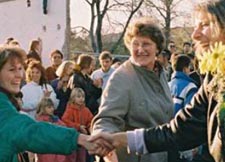
Tom reflected back, commenting that the border was calm as people crossed through the check point in a daze, seeing an alien world so different from theirs for the first time. They were handed flowers, and saw trees as they passed to the west.
"Strangers from the west approached us, they recognized we were from the east, they gave us cakes, and the children candy, my children smushed their noses into glass windows at stores..." he trails off.
"How did you feel Tom?" I ask. "I still have to cry," he says.
Committing the past to memory
"Democracy exists- it very quickly is taken for granted," Tom shares. He is relieved to know there are so many others interested in his exhibit for that reason.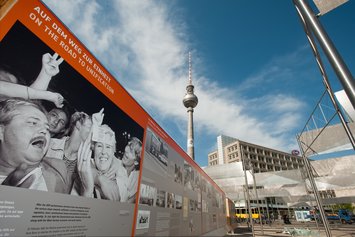
"Two years ago this exhibit would not have been possible--all previous nineteen years the Peaceful Revolution was not celebrated, except in one eastern city," Tom explains. This year is special because so many communities are celebrating with the 20th anniversary."
Sello, surprised to find out that the Fall of the Wall would be of such interest to so many people, said the first few days of the exhibit garnered more than 50,000 people. Each day brings no less than 5,000 onlookers.
To learn more on how you can help Tom Sello: Send a note of support to:
tom.sello@havemann-gesellschaft.de
Read more about Tom's Peaceful Revolution: http://www.revolution89.de (Under exhibits)
The exhibition (May8-November 14, 2009) is open around the clock, entrance is free free. Languages: German and English
Public Guided Tours:
Saturday 1:00 p.m. $5.00 Euro per person
Getting there:
Station: S+U Alexanderplatz, Berlin-Mitte
next to the World Time Clock
Direct link to booking information of Peaceful Revolution Exhibit
Berlin Tourism Information: Berlin.de
Tom Sello photo: Stefanie Michaels
Photos courtesy of: Robert Havemann Society